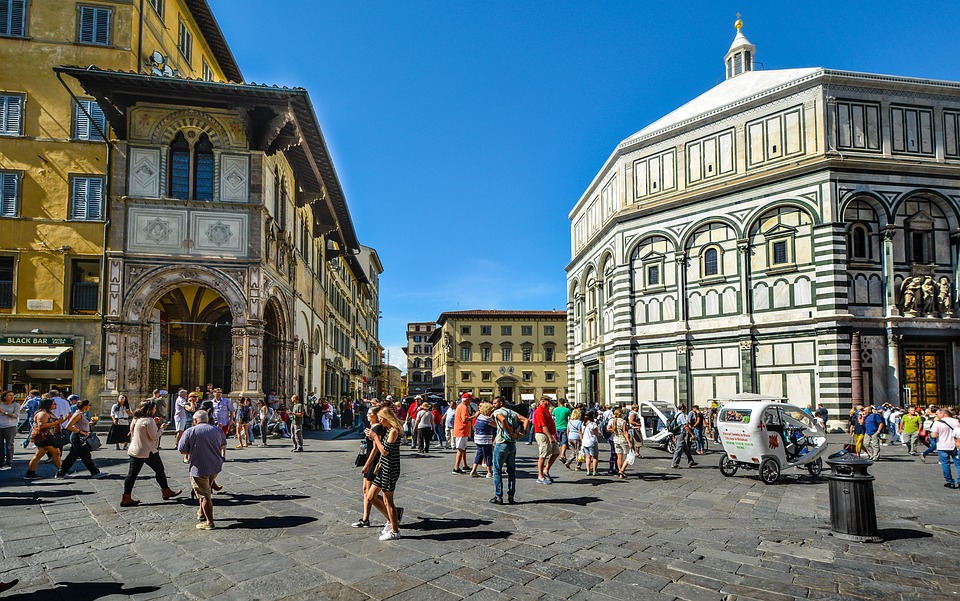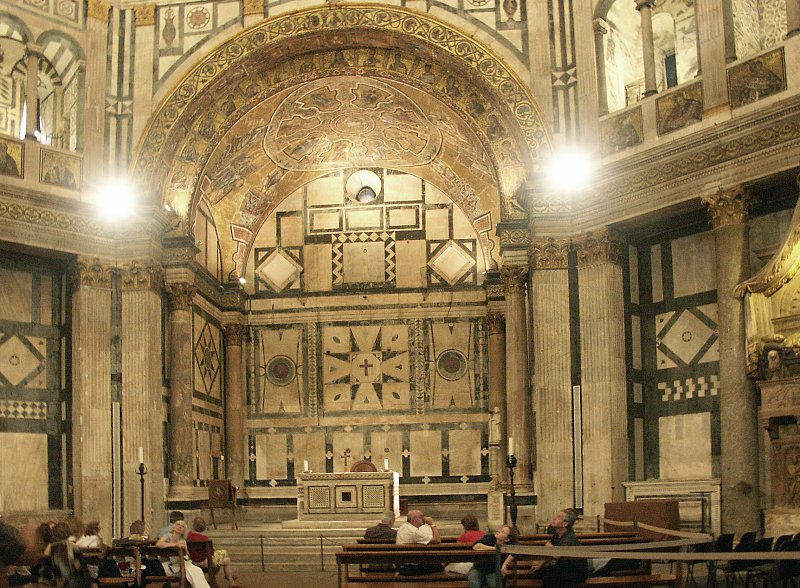During excursions in Florence, tourists are necessarily brought to admire the most beautiful buildings of the city.
The hallmark of the pearl of Italy was the ensemble of buildings in a single style. This is the beautiful cathedral of Santa Maria del Fiore, a high bell tower next to it called Giotto and the Baptistery, which will be discussed in our article.
Despite the unique marble finish, the inhabitants of Florence reacted negatively to such a reconstruction of the city center. Florentines believe that the real "face" of the ancient city are light brown buildings made of natural stones. Bright white and green marble tiles motley stand out from the rest of the structures of the historical center of Florence. Over time, even the most zealously protesting residents came to terms with this finish.
General information
The Baptistery of San Giovanni in Florence is considered the oldest building in the center. Its construction began in the 5th century; it served as the place of baptism for all those living in the city. These were ordinary people and important people, for example, representatives of the Medici family. Like most of these structures, it was consecrated in honor of John the Baptist.

In the article, we will consider the history of the construction and reconstruction of the Baptistery of San Giovanni in Florence, give a description of the interior decoration and the appearance of the building. We will pay special attention to the world-famous gates that amazed even the great Michelangelo. The presented photographs will help you plunge into the world of antiquity and magnificence of one of the most beautiful cities in Europe. Each stone of the pavement has preserved the memory of the steps of the great sculptors and artists, architects and creators of that time. Florentines are proud that their streets and squares have remained unchanged for hundreds of years, and carefully preserve this beauty for posterity.
History of creation
The construction site of the Baptistery of San Giovanni in Florence is considered sacred. Back in the 1st century, there was a pagan temple dedicated to the Roman god of war, Mars. Over time, changes were made to the architecture of the structure, in accordance with the fashion of those times, and then the adoption of Christianity. From the pagan temple by the 9th century, the building turned into a basilica.
In 1059, a global reconstruction began, after which the octagonal baptistery, completely completed in 1363, appears in the eyes of the inhabitants of the city. Its dimensions are impressive - 54.86 m in height. The Baptistery of San Giovanni in Florence is considered the largest in all of Italy. In the XII century, the building was trimmed with marble tiles of pale green and white. During this period, baptismal ceremonies were held in the baptistery, but at the same time it had the functions of a cathedral. In the 13th century, Giotto's bell tower was set up, standing away from the building.
Because of this versatility, the Florentine Baptistery is equipped with three gates, which we will discuss later in the article.
External characteristics of the structure
The octahedron of the building has religious significance. Each facet means one of the days of the creation of the world by God, and the eighth indicates the rite of baptism, when a person is reborn again. The baptistery is located on Cathedral Square, whose name in Italian sounds like Piazza del Duomo. The ensemble of buildings in white-green marble includes three buildings - the Baptistery itself, the bell tower and the magnificent cathedral, built later.
The only drawback of this beauty in Florence is the close location of buildings in the square. According to reviews, it is impossible for tourists to take photographs against the backdrop of the entire ensemble. And people in the city center simply can not be counted. If you are traveling in a group, then follow the direction of the guide, as looking at the beauty of the city streets and keeping up with the group is easy.
Interior decoration
The description of the Baptistery of San Giovanni in Florence will continue with an excursion inside. According to numerous reviews, going into a modest exterior of the building, many are surprised at the beauty of the interior. The first thing that impresses is the dome of the structure. All walls are represented by beautiful columns made of marble, like the floor. You can admire the altar of the XIII century and the font of the XVI century. Inside the baptistery is stored a tomb made by famous sculptors Donatello and Mikelozzo, the antipope John XXIII, created by skilled craftsmen in 1420. A representative of the Medici family also lies in these walls. Inside the baptismal room is the sarcophagus of Bishop Ranieri.

Previously, a baptismal spring was located at one of the inner walls of the baptistery. In its waters, the ceremony of the baptism of the Florentines from the 9th to the 19th century was performed. Its description can be read in Dante's Divine Comedy. However, now it no longer exists.
The windows of the building are decorated with stucco molding, and the rectangular pulpit with frescoes. The simplicity of the floor of the baptistery is designed not to distract visitors from the luxurious mosaic dome.
The beauty of the dome
The dome is represented by a beautiful mosaic of the XIII-XIV centuries, the creation of which worked by famous Byzantine masters. The eight ceiling faces depict scenes from the biblical Last Judgment with the central figure of Jesus Christ. They converge at a small point in the center, through the opening of which rays of daylight penetrate, illuminating the gold of the mosaic.
Seated Jesus is surrounded on all sides by characters of biblical action - angels, worldly affairs, and mortal sins. This scene takes as many as three faces. The remaining five are dedicated to other scripture scenes. Looking at the figures on the dome, you can recognize John the Baptist, the Virgin Mary, the Heavenly hierarchy, admire the moment of creation of life on Earth.
A thin tier with windows alternating with the faces of the saints separates the dome from the walls of the baptistery. A special contribution to the creation of beauty was made by the Italian artist Coppo di Marcovaldo.
Gate Baptistery
According to reviews, the special attention of all tourists is attracted by the gates of the structure. These are the eastern, southern and northern gates, each detail of which can be admired for a long time. The presence of this number of gates is explained by the fact that the baptism ceremony in Florence was held twice a year, so a huge number of people gathered on the square.
The southern gate created by Andrea Pisano at the beginning of the 14th century is considered the oldest. They have 28 bas-reliefs with scenes from the life of John the Baptist.
The northern ones were made later, at the beginning of the 15th century, by Lorenzo Ghiberti. They have the same number of bas-reliefs, but they already depict scenes from the New Testament.
The last, most famous east gate is directed directly to the Cathedral of Santa Maria del Fiore. We will consider them in more detail later.
The Gates of Paradise
This is the most famous gate, called by Michelangelo "the gateway to Paradise" for its extraordinary beauty. Lorenzo Ghiberti depicted scenes from the Old Testament on 10 square panels. However, the author’s original can be seen in the closed pavilion of the museum at the cathedral, and for public viewing a talented copy of Enrico Marinelli is on display.
During the war, the original was hidden in a suburb of Florence, so it is well preserved. Restore the gates began in 1947. The work was carried out for 27 years. Now they are stored under thick glass with a constant temperature and humidity.
Portrait of the author
In addition to the scenes of the creation of the first people - Adam and Eve, the fratricide, the Flood, the victory of David over Goliath, as well as the handshakes of Solomon and Queen of Sheba, the "modest" Ghiberti captured small sculptural heads located in round medallions - his and his nephew, who helped him during the execution of the gate.
They serve as door handles. It is interesting to know that for the gates of the Kazan Cathedral in St. Petersburg a copy was made according to casts from the "gates of Paradise", so the inhabitants of our country can also admire a copy of the famous doors. However, in the domestic version, the bas-reliefs are arranged in a different order.
We introduced readers to one of the most important sights of Florence, a photo and description of the baptistery will help you better understand the meaning of the guide’s story during a trip to Italy.